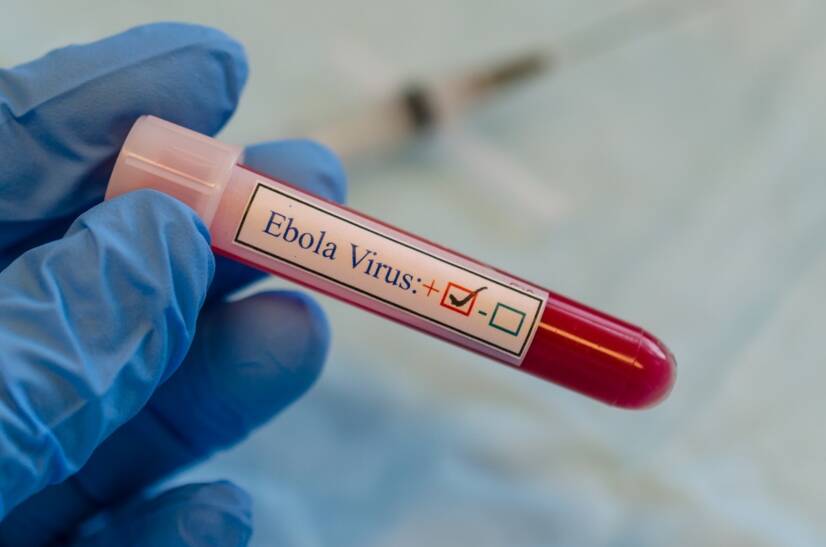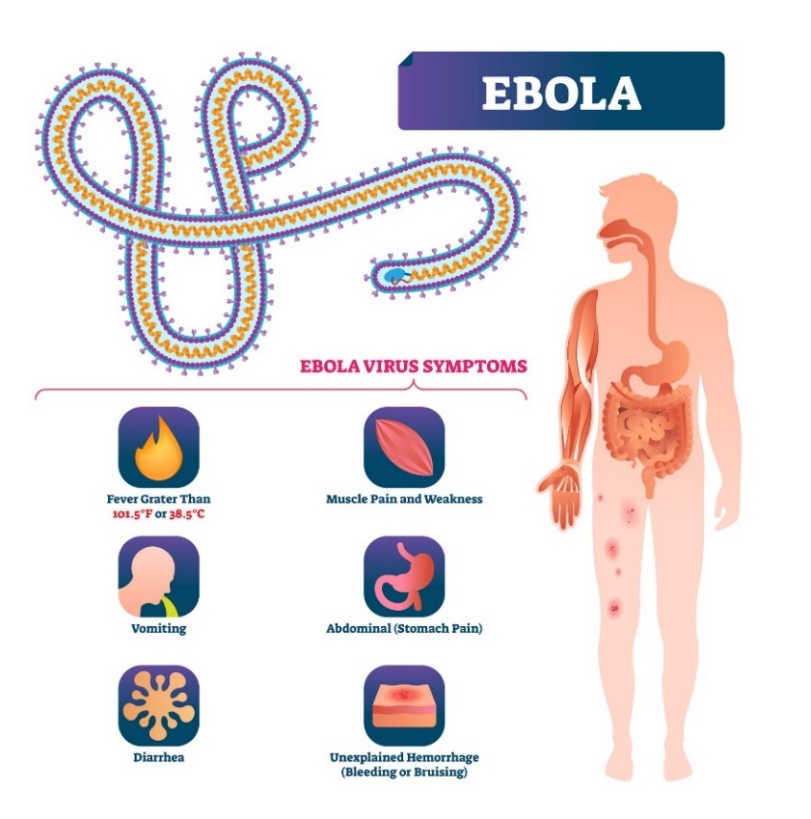- health.gov.sk - EBOLA virus
- medicalnewstoday.com - Ebola: What you need to know. Medical News Today. Hannah Nichols
- healthline.com - Ebola virus and the disease. Healthline: Ebola and its symptoms. Rachel Nall, MSN, CRNA
- ruvzse.sk - Summary of the Ebola epidemic
Ebola: What are the symptoms?

Ebola is one of the world's most dangerous diseases, with a high mortality rate. Where does the Ebola virus come from and how is this serious infectious disease transmitted?
Most common symptoms
- Malaise
- Chest pain
- Abdominal Pain
- Headache
- Joint Pain
- Muscle Pain
- Spirituality
- Fever
- Increased body temperature
- Nausea
- Diarrhoea
- Bleeding
- Blue leather
- Indigestion
- Low blood pressure
- The Island
- Petechie
- Disorders of consciousness
- Stool with blood - blood in the stool
- Dry cough
- Muscle weakness
- Pressure on the chest
- Vomiting
- Winterreise
- Accelerated heart rate
Characteristics
Ebola is characterised by a relatively rapid onset, pain and haemorrhagic fever. It is a viral disease with a worldwide distribution. Currently, its incidence in developed countries is minimal.
The etiology, transmission, symptoms, treatment options, the situation in the world, advances with the vaccine and much more interesting information can be found in the following article.
Ebola is an RNA virus of the filovirus family (Filoviridae). Ebolavirus has an elongated filamentous shape with protrusions and a diameter of approximately 80 nm and an average length of 790-1000 nm. However, the maximum length is 1400 nm.
Ebola virus was discovered in connection with an epidemic in 1976 in the African countries of Zaire (now the Democratic Republic of Congo) and Sudan.
The main Ebola epidemic began in December 2013 in the West African state of Guinea. It gradually began to spread to neighbouring countries.
Currently, 5 different strains of the virus are known.
The most dangerous strain is Ebola Zaire, which has the highest mortality rate.
The second strain is Ebola Sudan, which has a mortality rate of approximately 60%.
The virus is divided into subtypes named according to place of origin: Bundibugyo, Reston, Sudan, Ivory Coast and Zaire.
Ebolavirus is a serious acute infectious disease.
In infected people, it causes mainly haemorrhagic fever. The disease is characterised by high infectiousness and mortality.
Causes
The Ebola virus is transmitted mainly through bodily fluids (blood, saliva, stool, urine or semen and vaginal secretions).
Transmission can occur through unprotected sexual contact (vaginal, anal and oral).
Transmission can also occur through inadequately sterilised instruments such as syringes and needles. This is particularly common in countries with low levels of hygiene and health.
Humans can also become infected through close contact with the blood or other bodily fluids of live or dead wild animals such as monkeys, chimpanzees, antelopes, porcupines and bats, among others.
Consumption of unprocessed meat from the risk area is also risky.
Airborne transmission is minimal as Ebola is not transmitted by normal human-to-human contact. Handling money or common objects poses little risk.
Insects, including mosquitoes, do not transmit the virus.
Currently, when travelling to areas of Africa, the risk of contracting Ebola virus disease is very low unless an individual comes into contact with the body fluids of living or dead infected persons or animals.
At the same time, due to the potential risk of inadequate hygiene and sanitation standards in health facilities in areas at risk of Ebola virus disease, there may be an increased risk of transmission for travellers seeking medical care in a given health facility.

Symptoms
The infection begins with high fever, chest and abdominal pain, nausea, diarrhoea and muscle and joint pain. There is general weakness, malaise and excessive fatigue.
Laryngeal pain, airway inflammation and dry cough are also common.
The most risky manifestations of Ebola are external and internal bleeding and subsequent failure of the body's internal systems.
There is excessive loss of water and blood from the body. In some cases, jaundice may also be a manifestation of Ebola.
Summary of possible symptoms of the Ebola virus:
- Fever (high body temperature)
- Diarrhoea (watery stools)
- Nausea and vomiting
- Fatigue and weakness
- Joint and muscle pain
- Chest pain
- Abdominal pain
- Pain in the digestive tract
- Inflammation of the larynx
- Dry cough
- Red skin rash (petechiae)
- Nosebleed
- Vomiting blood
- Bloody stools
- Bleeding gums
- Subcutaneous hematoma
- Internal bleeding

Diagnostics
Due to the non-specific initial symptoms, diagnosis can be quite challenging. Therefore, it is essential to take a complete patient history and identify possible animal or human infection in areas at increased risk of infection.
In particular, the physician examines the patient's travel history to countries with a high risk of infection.
It is necessary to distinguish Ebola from other diseases with initial similar symptoms, such as malaria, cholera or other bleeding fevers.
A blood sample from the patient is required to confirm Ebola virus.
Viral antibodies and the presence of Ebola virus in the blood are evaluated by laboratory.
Blood tests also show abnormal white blood cell counts, low platelet counts, elevated liver enzymes, or pathological levels of coagulation factor in the blood.
When Ebola is suspected, the examining physician determines the risk of contagion and orders quarantine and isolation of the patient.
Course
The incubation period from first infection with the virus is relatively short. Most often, the first symptoms of the disease appear in 3 days to 2 weeks.
The incubation period of the Ebola virus is 2-21 days.
The first symptoms are high body temperature, abdominal pain, headache, nausea, vomiting and watery stools - diarrhoea. Dehydration occurs due to excessive water loss.
After a few days, a specific red rash may appear on the skin. Inflammation of the respiratory tract, cough and chest pain, muscle and joint pain appear.
After about the first week, more serious symptoms appear, namely bleeding.
There is external bleeding from various body orifices as well as more dangerous internal bleeding. Bleeding inside the body damages organs and can cause organ failure.
Bleeding is manifested by bloody stools, bloody diarrhea, coughing up and vomiting blood, bleeding from the gums of the mouth and nose, and visible blood in the subcutaneous tissue (bruising).
Within 2 weeks, the disease is eliminated by appropriate treatment and the individual's strong immune system. The health condition slowly improves. Otherwise, the infected individual dies within the second week due to blood loss and organ failure.
Sometimes the Ebola virus can present as a slightly milder illness - similar to the more severe manifestations of influenza.
Preventing Ebola virus disease
There is no 100% prevention of Ebola virus disease per se.
However, it is necessary to eliminate the risks of transmission - avoid travel to high-risk focal countries, avoid consumption of untested food or water sources, hygiene, protected sex, etc.
Symptoms should be monitored in individuals who have travelled to high-risk countries in the past. If high fever, excessive fatigue, diarrhoea or other clinical symptoms (vomiting, bleeding, abdominal or headache) occur within days or weeks of return, medical attention should be sought immediately. In the first instance, the travel history should be reported to the doctor.
How it is treated: Ebola
How is Ebola treated? Drugs, vaccinations
Show moreEbola is treated by
Other names
Interesting resources










